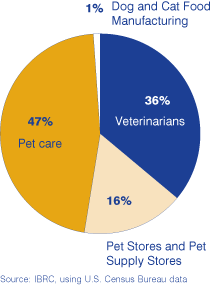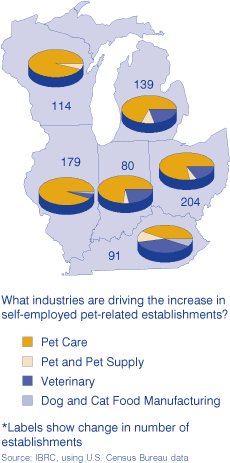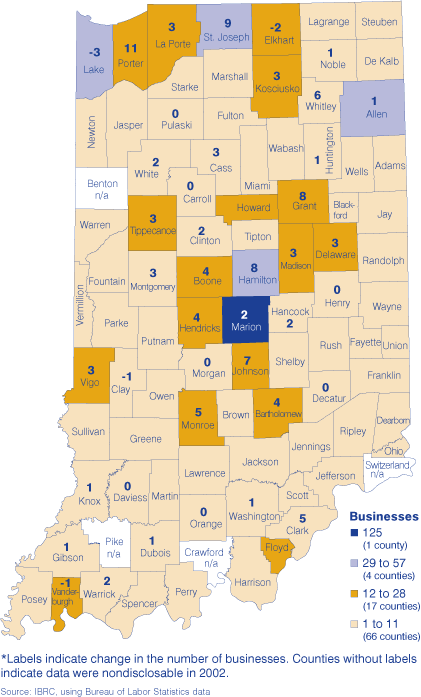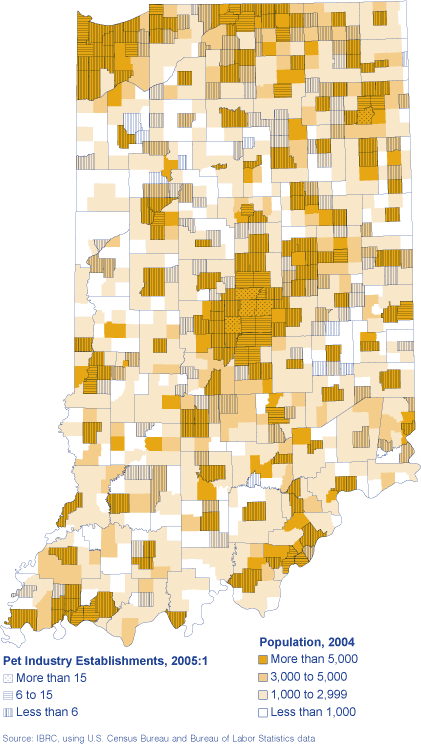The Pet Industry: Another View of Economic Well-Being
We may soon have to broaden our definition of consumer to include our furry friends. The pet industry has become more prevalent over the last five years and might even be considered a "watch industry" for the nation's economic well-being in terms of disposable income (since having a pet is not a necessity, nor are the kinds of pet care services that are spreading across the country). In 1988, 56 percent of households owned a pet as compared to 63 percent today, according to the American Pet Products Manufacturers Association. (1)
In 2002, the nation had 360,000 paid employees working in industries devoted to pet care and maintenance and generated $38 billion in sales (see Table 1). The average establishment with paid employees engaged in pet services was a small business employing nine people in both the United States and Indiana. Veterinary services had the lion's share of employment for the nation and the state in this industry (66 percent) and pet and pet supply stores followed with a fifth of the employment. In the nation, there were 101,000 establishments in the pet industry with 46 percent of those businesses operating pet care businesses.
Table 1: U.S. Pet Industry, 2002
The pet care industry code includes pet boarding, sitting, grooming and training services. Table 2 looks at the different product lines contained in the pet care industry for employers with paid employees and is highlighted in Tables 1 and 3. It is apparent that pet grooming and boarding services is the biggest moneymaker for businesses in the pet care industry. Pet grooming and boarding services boasts 77 percent of the sales for this NAICS code and of those businesses claiming to have pet grooming and boarding services, 89 percent of total sales is derived from pet grooming and boarding. Also, some pet and pet supply stores offer boarding and grooming services and this constitutes 3.9 percent of their sales.
Table 2: U.S. Pet Care Industry Product Lines
Table 3: Indiana Pet Industry, 2002
The 50 largest firms only comprised 1.2 percent of all the businesses in the pet care industry, indicating a lot of small players in the market. However, revenue is more concentrated with 15 percent of sales coming from the 50 largest firms.
There are 1,748 grocery and related-product merchant wholesalers that have pet food as a product line and generate $13.5 billion from pet food sales. Of those wholesalers with pet food as a product line, 15 percent of their total sales come from pet food.
Indiana had approximately 8,400 paid employees working in pet-related industries that generated $1 billion in sales for the year. Dog and cat food manufacturers employed the greatest number of employees and generated the most revenue per establishment (see Table 3). Like the nation, Indiana's greatest number of businesses is in pet care and are individuals operating their own pet-sitting, boarding and grooming services (see Figure 1). The pet industry has grown significantly over the past five years as evidenced by the unavailability of veterinary services and pet care data in the 1997 economic census.
Figure 1: Indiana Pet Businesses, 2002

From 2002 to 2004, the nation has gained 1,667 pet industry private businesses (excluding self-employed individuals), 790 of which are pet care businesses. This is a 4.0 percent increase for the pet industry and a 9.7 percent increase for the pet care industry. Indiana, on the other hand, is growing slower with 16 new private businesses overall (1.8 percent change), 11 of which are pet care businesses (7.1 percent change). Indiana's average annual pay for workers in this industry ($20,520) is also $4,208 less than the nation and the pay gap has widened by $1,692 since 2002. Figure 2 shows which industries are leading the growth in the pet industry for the self-employed with their own operation. The majority of new pet businesses are in the pet care industry in the Midwest. There were 80 new establishments in Indiana, 60 of which were in pet care.
Figure 2: Growth in Self-Employed Businesses in the Pet Industry, 2002 to 2003

In the first quarter of 2005, there were 939 pet industry establishments in Indiana, excluding those who were self-employed. Figure 3 shows the state's distribution of establishments covered by unemployment insurance in the pet industry. The greatest number of businesses are found in Marion County, followed by Hamilton, Lake and Allen counties. Porter County had the greatest net increase in the number of new pet establishments (11).
Figure 3: Change in Number of Businesses, 2002:1 to 2005:1

Figure 4 shows all of the pet establishments in the state and the population estimates for townships. Assuming that a greater township population would mean a greater pet population, this map may be useful for a new business in the pet industry trying to locate within the state.
Figure 4: Population and Pet Industry Establishments
Notes
- American Pet Products Manufacturer's Association (APPMA): 2005/2006
National Pet Owners Survey.
Amber Kostelac, Data Manager
Indiana Business Research Center,
Kelley School of Business, Indiana University




